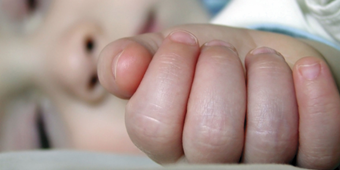8 Breastfeeding Tips for Latching On

Find Your Perfect Match
Answer a few questions and we'll provide you with a list of primary care providers that best fit your needs.
What’s the number one key to successful breastfeeding? Many experts — including breastfeeding moms — say, “It’s all in the latch!”
“The way your baby connects with the breast is called the latch,” says Maria Greene, RN, BSN, IBCLC at Miami Valley Hospital. “Latching on effectively prevents sore nipples, ensures sufficient milk supply, and stimulates plentiful milk production.”
In a good latch, the baby’s mouth is full of breast and you feel comfortable.
 These tips can make latching on easier:
These tips can make latching on easier:
- Make sure the baby is positioned correctly. Turn the baby’s entire body toward you, with her nose and chin against the breast. The baby should not turn her head to drink. You should be able to draw a straight line that connects the baby’s ear, shoulder, and hip on either side of the baby’s body.
- Using your free hand, place four fingers under your breast and your thumb on top to present the nipple to your baby. This is sometimes called a C-hold, since your hand makes the shape of a letter C.
- Stroke your baby’s lower lip with your nipple or bring his chin in to touch the breast closely. This causes him to open his mouth. When he opens as wide as a yawn, quickly draw him closer and quickly but gently place his open mouth fully on your breast. Remember you’re bringing your baby to the breast, not pushing your breast into his mouth, which might make him agitated or frightened.
- Watch baby’s lower lip and aim it as far from the base of the nipple as possible.
- “Remember, your breast — not just the nipple — is feeding the baby,” points out Greene. “The nipple and as much as possible of the areola (the dark ring around the nipple) should be in your baby’s mouth. Make sure your fingers are behind the areola so it doesn’t get in the way of your baby’s latching on. You can provide gentle compression of the breast with your fingers to make it easier for your baby to latch.”
- If a latch hurts, gently slide a finger into your baby's mouth to release the latch so you can try again.
- In a good latch, the baby’s mouth is full of breast and you feel comfortable.
- Most babies will learn to breastfeed effectively, but don’t hesitate to contact a certified lactation consultant (IBCLC) or your baby's doctor if you have trouble with latching. Often the right advice can quickly correct a problem.
Find Your Perfect Match
Answer a few questions and we'll provide you with a list of primary care providers that best fit your needs.
Source: healthychildren.org; womenshealth.gov; Maria Greene, RN, BSN, IBCLC





